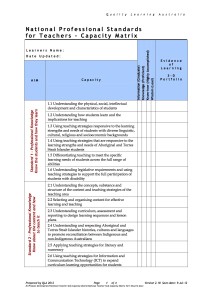Do you need a step-by-step guide to targeting professional learning to develop your expert teaching team? Then follow these simple instructions to establish an evidence-based, structured process to plan, monitor and evaluate the professional development of staff in your school:

- Download a capacity matrix template. You can use the matrix in either hardcopy or digital format.
- Agree with staff what they need to know, understand and be able to do to be effective in their school roles. Identify the specific skills and capacities as they relate to key concepts and methods. Insert them into the matrix template. Draw on preferred models and professional standards like the AITSL Australian Professional Standards for Teachers. Be sure to also include the capacities unique to your school system (e.g. do you have a school-based data software people need to know how to use, a behaviour management policy, a role call process?).
Also consult your Strategic and Annual Plans for new developmental needs and these capacities to the matrix. In this way the matrix is a dynamic (ever evolving) document subject to ongoing review and improvement. - Have each staff member undertake a regular self-assessment using the matrix. This self-assessment can be made an integral part of your school staff performance management/development process.
- Staff (like younger learners) are required to provide evidence of their learning. Evidence is recorded in the evidence column of the matrix. Staff can use a portfolio to store their evidence (in the same way as students do). This can take many forms; video footage or podcasts of teachers demonstrating good teaching practice, photos, students articulating their learning. This evidence is an effective measure of the extent to which professional learning is ultimately applied in the classroom.
- Use the capacity matrix to identify individual learning goals and monitor progress towards achieving them.
- Use the matrix as a basis for the induction of new staff.
- Use the matrix to plan ongoing professional development. Identify those areas where a majority of staff require professional development and plan the most cost-effective way for this to be facilitated. For example, those staff who have reached mastery (or are at the wisdom level) in specific capacities can teach, coach or mentor those at lower levels of learning.
Here are some we prepared earlier!
- Based upon the Australian Professional Standard for Teachers.
- Based upon the NSW Quality Teaching Model
- Based upon QLA’s Quality Learning
Want to know more…?
- Watch a video of a teacher (Warwick) explaining his Capacity Matrix and Digital Learning Portfolio.
- Purchase a Capacity Matrix Guide.
- Explore examples of Capacity Matrices for younger learners.
- Investigate the key learning improvement concepts underpinning the use of the capacity matrix in our new book IMPROVING LEARNING: A how to guide for school improvement.

